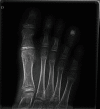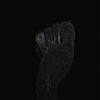Osteoid Osteoma: A Unique Presentation in a Child's Lesser Toe
- PMID: 34367707
- PMCID: PMC8337121
- DOI: 10.1155/2021/8876584
Osteoid Osteoma: A Unique Presentation in a Child's Lesser Toe
Abstract
Introduction: Osteoid osteoma is an uncommon, small, benign, self-limiting, and usually painful tumor of the skeleton. Diagnosis can be straightforward if seen in the usual locations as the femur and the tibia in young adults, who present with nocturnal pain, alleviated by salicylates. The diagnosis can be more challenging in the spine, pelvis, hand, or feet. Case Report. We report the case of an 11-year-old boy who was treated symptomatically for a painful toe since 10 months, without a definitive diagnosis. X-ray, MRI, and scintigraphy, along with the typical nocturnal pain and swelling of the toe, suggested an osteoid osteoma, confirmed by histology after excisional biopsy of the lesion.
Conclusion: Osteoid osteoma should always be included in the differential diagnosis when it comes to nocturnal pain without systemic signs, even in unusual places in children. The awareness should lead to a prompt diagnosis and treatment.
Copyright © 2021 Michel Bellemans et al.
Conflict of interest statement
The authors declare that they have no conflicts of interest.
Figures





References
-
- Jaffe H. L. Osteoid-osteoma. Archives of Surgery. 1935;31(5):p. 709. doi: 10.1001/archsurg.1935.01180170034003. - DOI
Publication types
LinkOut - more resources
Full Text Sources

